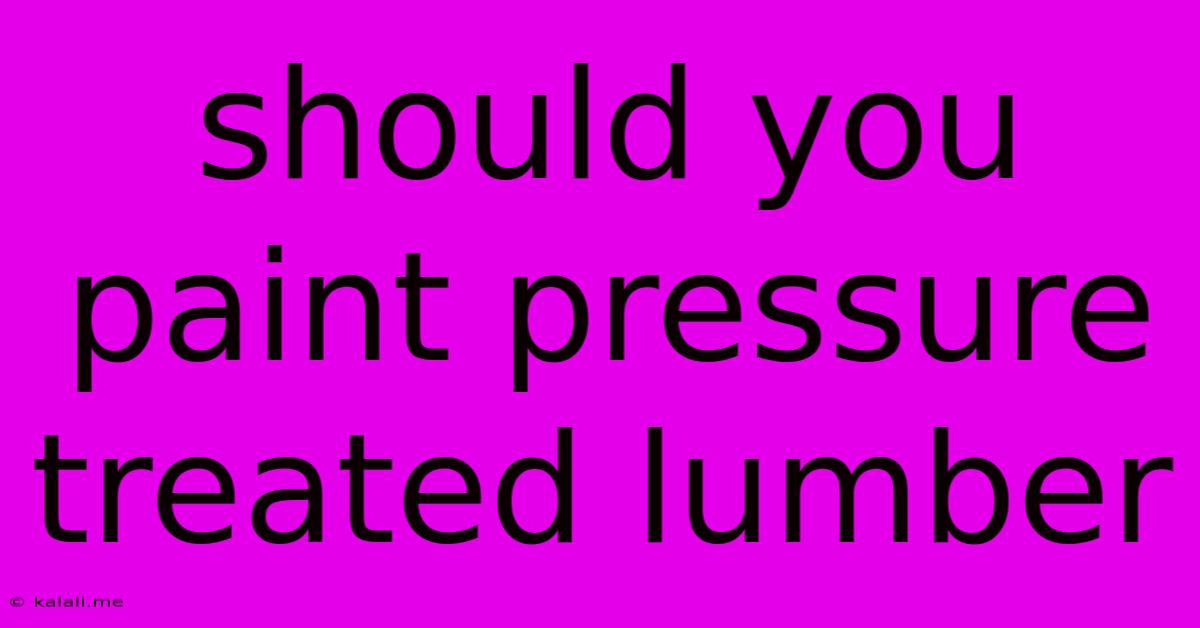Should You Paint Pressure Treated Lumber
Kalali
May 20, 2025 · 4 min read

Table of Contents
Should You Paint Pressure Treated Lumber? The Definitive Guide
Meta Description: Deciding whether to paint pressure-treated lumber is a common dilemma. This guide explores the pros and cons, offering expert advice on when painting is beneficial and when it's best avoided, along with preparation tips for a long-lasting finish.
Pressure-treated lumber offers durability and resistance to rot and insect damage, making it a popular choice for outdoor projects like decks, fences, and retaining walls. But should you paint it? The answer isn't a simple yes or no. It depends on several factors, including the type of treatment, your climate, and your aesthetic preferences. This comprehensive guide will help you make the informed decision that's right for your project.
Understanding Pressure-Treated Lumber
Before diving into the painting question, let's briefly cover the basics. Pressure-treated lumber undergoes a process that forces preservatives deep into the wood, protecting it from decay and pests. These preservatives, often containing copper azole, copper naphthenate, or chromated copper arsenate (CCA – though less common now due to environmental concerns), are what make the wood resistant to the elements.
The Pros of Painting Pressure-Treated Lumber
- Enhanced Aesthetics: This is perhaps the most compelling reason. Pressure-treated lumber's natural green or brown hue isn't always aesthetically pleasing to everyone. Paint allows you to customize the look to match your home's style and surroundings. You can achieve a variety of finishes, from a classic stained look to a bold, vibrant color.
- UV Protection: Sunlight's UV rays can degrade the wood over time, leading to fading and discoloration. Paint acts as a protective barrier, slowing down this degradation process and preserving the wood's appearance for longer. This is particularly important for projects exposed to direct sunlight.
- Moisture Management: While pressure-treated lumber is resistant to rot, excessive moisture can still cause problems. A high-quality paint can provide a moisture barrier, further protecting the wood from the damaging effects of prolonged dampness. This is crucial in humid climates.
- Improved Durability: A properly applied paint finish can add another layer of protection against scratches, dents, and general wear and tear, extending the lifespan of your outdoor structures.
The Cons of Painting Pressure-Treated Lumber
- Trapped Moisture: If the wood isn't properly prepared before painting, moisture can become trapped beneath the paint, leading to rot and mildew growth. This is a significant concern and requires meticulous preparation.
- Chemical Reactions: In some cases, the chemicals in the pressure treatment can react with certain paints, causing blistering, peeling, or discoloration. It's essential to use a paint specifically formulated for pressure-treated lumber.
- Added Cost and Labor: Painting adds to the overall cost and time investment of your project. Proper preparation and application require careful attention to detail.
- Maintenance: While paint protects the wood, it's not a permanent solution. You'll need to repaint periodically to maintain the finish and protection. The frequency depends on the paint quality, climate, and exposure to the elements.
When to Paint (and When Not To)
Paint it if:
- You want to improve the aesthetics of your project.
- Your project is in a harsh climate with intense sun exposure and/or high humidity.
- You want to add extra protection against weathering and wear.
- You're using a paint specifically formulated for pressure-treated wood.
Don't paint it if:
- You prefer the natural look of pressure-treated lumber.
- You're concerned about the added cost and labor.
- You're in a dry climate with minimal sun exposure.
- You're not prepared to properly prepare the wood before painting.
Preparing Pressure-Treated Lumber for Painting
Proper preparation is crucial for a successful paint job. This involves:
- Allowing Sufficient Curing Time: New pressure-treated lumber needs time to dry and allow the chemicals to dissipate. This typically takes several weeks or months, depending on the type of treatment and climate. Check the manufacturer's recommendations.
- Cleaning the Surface: Remove any dirt, debris, mildew, or loose fibers using a stiff brush and a suitable cleaner.
- Sanding (Optional): Lightly sanding the surface can create a better surface for the paint to adhere to.
- Priming (Recommended): Applying a primer specifically designed for pressure-treated lumber helps to seal the wood and provide a better base for the paint.
By carefully weighing the pros and cons and following proper preparation techniques, you can make an informed decision about whether or not to paint your pressure-treated lumber, ensuring a beautiful and long-lasting outdoor structure.
Latest Posts
Latest Posts
-
Can You Carry Glass In Hand Luggage
May 21, 2025
-
Three Breasted Woman In Total Recall
May 21, 2025
-
Macos High Sierra The Recovery Server Could Not Be Contacted
May 21, 2025
-
How To Fill Deep Holes In Wall
May 21, 2025
-
How To Clean Concrete Off Brick
May 21, 2025
Related Post
Thank you for visiting our website which covers about Should You Paint Pressure Treated Lumber . We hope the information provided has been useful to you. Feel free to contact us if you have any questions or need further assistance. See you next time and don't miss to bookmark.